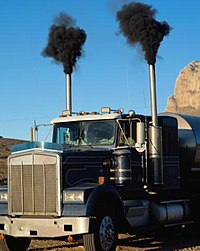
Photo from wikipedia
The aim of this study was to simulate a banned but widely spread practice of co-combustion of plastic with wood in a small residential boiler and to quantify its impact… Click to show full abstract
The aim of this study was to simulate a banned but widely spread practice of co-combustion of plastic with wood in a small residential boiler and to quantify its impact on emissions of gaseous pollutants, particulate matter (PM), polycyclic aromatic hydrocarbons (PAHs), and 1,3,5-triphenylbenzene (135TPB), a new tracer of polyethylene plastic combustion. Supermarket polyethylene shopping bags (PE) and polyethylene terephthalate bottles (PET) were burnt as supplementary fuels with beech logs (BL) in an old-type 20 kW over-fire boiler both at a nominal and reduced heat output. An impact of co-combustion was more pronounced at the nominal heat output: an increase in emissions of PM, total organic carbon (TOC), toxic equivalent (TEQ) of 7 carcinogenic PAHs (c-PAHs) and a higher ratio of c-PAHs TEQ in particulate phase was observed during co-combustion of both plastics. 135TPB was found in emissions from both plastics both at a nominal and reduced output. In contrast to findings reported in the literature, 135TPB was a dominant compound detected by mass spectrometry on m/z 306 exclusively in emissions from co-combustion of PE. Surprisingly, six other even more abundant compounds of unknown identity were found on this m/z in emissions from co-combustion of PET. One of these unknown compounds was identified as p-quaterphenyl (pQ). Principal component analysis revealed strong correlation among 135TPB, pQ and five unknown compounds. pQ seems to be suitable tracers of polyethylene terephthalate plastic co-combustion, while 135TPB proved its suitability to be an all-purpose tracer of polyethylene plastics combustion.
Journal Title: Chemosphere
Year Published: 2018
Link to full text (if available)
Share on Social Media: Sign Up to like & get
recommendations!